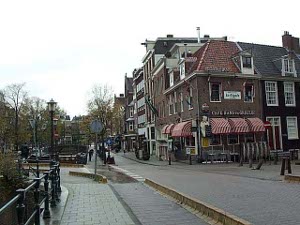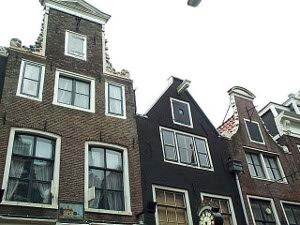 The Spiegel antiques quarter
The Spiegel antiques quarter
A front is moving through; it's windy and colder and continues to sprinkle off and on, all of which makes walking tours less fun. This morning when the sprinkle turned on, we returned for rubbers and umbrella. Of course the umbrella doesn't care for the wind, and neither does Cuddles.
 The Spiegel antiques quarter
The Spiegel antiques quarter
We started through the Spiegel Quartier with shops of antiques, from furniture to silver to glassware to globes and full-sized suits of armor and old portraits. The fallen leaves, in soggy piles on grass and sidewalk, made us both nostalgic. Along the canals, the facades of the houses are varied, and sometimes there is a little picture instead of a house number. Boats, some filled with tourists, putted through the canals. We saw the typical feature of beam and hoist extending from the top story of the house to let furniture be brought in through the windows.
Then we entered the Red Light District. Our prediction that it would be deserted on a cool, wet Sunday morning was quite incorrect. We found ourselves in the midst of wide-eyed tourists, young couples, and a variety of businesspeople and their customers. And yes indeed there are windows with curtains sometimes open and sometimes closed. The sex businesses are  Canal scene
interspersed with bars, fast food, and Coffee Shops. Coffee Shops (not cafes) are the businesses which sell marijuana and hashish.
Canal scene
interspersed with bars, fast food, and Coffee Shops. Coffee Shops (not cafes) are the businesses which sell marijuana and hashish.
Several of the streets through the Red Light District had been torn up for street repairs, and people got around on slippery plywood planks laid over the mud. All in all the effect was quite sordid. We puzzled over why we were so disgusted with Amsterdam's Red Light District yet had not minded Hamburg's Reeperbahn. The Reeperbahn was a wide boulevard with wide sidewalks, and contained bakeries, theaters, arcades, and wax museums interspersed with the sex shops; also the actual bordellos were on a side street, and we saw no prostitutes.
The Amsterdam train station is always crowded. We wasted an hour there as follows: the information agent said we didn't need reservations to Brussels, we said we wanted them, she said why, we said because people were standing on the train to Amsterdam on Friday. We asked if we could make reservations, she said yes and gave us a number. We waited and waited until our number was called, whereupon the reservations agent informed us the train did not accept  Typical beam-and-hoist
reservations. So the Dutch railway system is not user friendly.
Typical beam-and-hoist
reservations. So the Dutch railway system is not user friendly.
That adventure completed, we rode the subway to see the Jewish Historical Museum. Its five themes are the Jewish religion; Zionism and the bonds with Israel; Nazi persecution and its survivors; the personal history of some Jews in the Netherlands; and the interactions between the Jews and the Dutch in the Netherlands. In addition, there is a wonderful Jewish childrens' museum on the top floor.
The museum is built on two former synagogues; the Great Synagogue of 1671, and the New Synagogue of 1752. Some of the things we learned were that during the middle ages the Jews were prohibited from joining many of the artisans' guilds. That left them city jobs as merchants and bankers, which were free occupations (without guilds). Also, there was no guild for diamond cutting, so the Jews in the Netherlands entered that work.
Some of the Jews in the Netherlands became interested in the Zionist movement as early as 1901. The museum indicated these were often the less religious members of the community, but didn't explain why. There were 200,000  Sabbath table
Jews in the Netherlands before the Second World War; only 20% survived.
Sabbath table
Jews in the Netherlands before the Second World War; only 20% survived.
This is one of the most beautiful museums we have visited. Captions are in Dutch and English. Each of the five themes is thoroughly covered; for example, the principal holidays and ceremonies of the Jewish religion are explained. Some of our unanswered questions deal with the relationships of this Jewish community to Israel and to the Jews in the United States, but those issues were beyond the scope of the museum.
The Netherlands, like most European countries, was a colonial power in the sixteenth to early twentieth centuries, and the Dutch, through their colonies in present-day Indonesia, grew fond of Indonesian cooking. We like it, too, and Indonesian restaurants are rather uncommon in the U.S. We picked one of five or six we had walked by and stuffed ourselves on Sate Rijstaffel, which served as lunch and dinner!